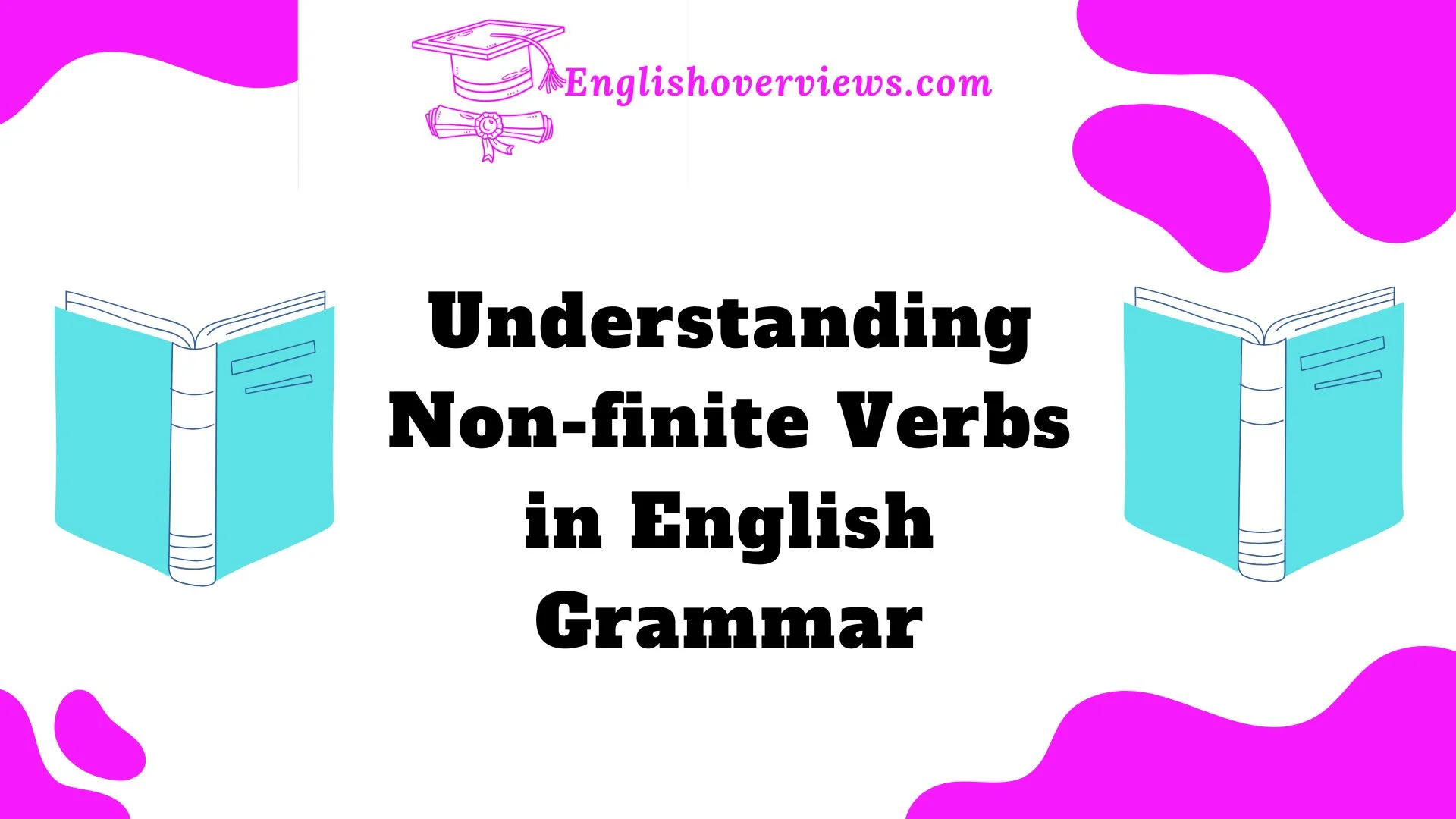Non-finite verbs are a fascinating yet often misunderstood part of English grammar. They add depth and versatility to your sentences, allowing you to express complex ideas with ease. Unlike finite verbs, which are bound by tense, subject, and number, non-finite verbs remain unaffected by these constraints. Think of them as the “wildcards” of grammar flexible, multipurpose, and indispensable.
Have you ever wondered how sentences like, “To read is to travel without leaving your chair” work? That’s the beauty of non-finite verbs! Whether you’re writing an essay, a business email, or even a novel, understanding these verbs will help you improve clarity and elegance in your writing.
In this comprehensive guide, we’ll cover everything you need to know about non-finite verbs. We’ll explore their types, uses, and real-world examples, and provide practical tips for mastering them. By the end of this blog post, you’ll not only understand non-finite verbs but also feel confident using them in your writing. So, let’s get started!
Breaking Down Non-finite Verbs: Definition and Characteristics
What Are Non-finite Verbs?
A non-finite verb is a verb form that does not show tense, person, or number. It doesn’t function as the main verb in a sentence but instead works as a noun, adjective, or adverb. Unlike finite verbs, which are limited by the grammatical rules of tense and subject agreement, non-finite verbs are versatile and static.
For example:
- Finite Verb: She runs every morning. (runs = finite verb, present tense)
- Non-finite Verb: She loves running every morning. (running = non-finite verb, acts as a noun)
Key Characteristics of Non-finite Verbs
- No Tense or Subject Agreement: Non-finite verbs remain unchanged regardless of the subject or tense.
- Example: They enjoy swimming. (swimming does not change based on subject or tense.)
- Functionality: They can act as nouns, adjectives, or adverbs.
- Example: To dance is her passion. (to dance acts as a noun, the subject of the sentence.)
- Dependency: Non-finite verbs cannot stand alone as the main verb of a sentence.
What Sets Non-finite Verbs Apart?
Finite vs. Non-finite Verbs
Understanding the difference between finite and non-finite verbs is crucial. Here’s a quick comparison:
| Aspect | Finite Verbs | Non-finite Verbs |
| Tense Agreement | Changes with tense (I run, I ran) | Does not change (Running is fun) |
| Subject Agreement | Matches the subject (He eats) | No agreement (Eating is enjoyable) |
| Function | Main verb of a clause | Acts as a noun, adjective, or adverb |
Why Non-finite Verbs Are Important
Non-finite verbs are indispensable because they:
- Simplify Sentences: Add information without creating additional clauses.
- Enhance Writing Style: Allow for variation and complexity.
- Enable Description: Provide vivid detail about actions and characteristics.
Example:
- Finite Verb: He sings beautifully and impresses everyone.
- Non-finite Verb: Singing beautifully, he impressed everyone.
Identifying Non-finite Verbs in Sentences
How to Spot Non-finite Verbs
- Look for “to” or endings like -ing or -ed:
- To write
- Writing
- Written
- Determine the Function: If the verb acts as a noun, adjective, or adverb, it’s non-finite.
- Check if It Stands Alone: Non-finite verbs can’t serve as the main verb of a clause.
Examples in Action
- Reading improves your knowledge. (Reading is a gerund, functioning as the subject.)
- He has a project to complete. (To complete is an infinitive, functioning as an adjective.)
- The broken vase lay on the floor. (Broken is a past participle, functioning as an adjective.)
The Three Faces of Non-finite Verbs: Gerunds, Participles, and Infinitives
Non-finite verbs come in three forms: gerunds, participles, and infinitives. Each has unique characteristics and functions.
1. Gerunds: Verbs Acting as Nouns
What Are Gerunds?
A gerund is a verb form ending in -ing that functions as a noun. It can act as the subject, object, or complement in a sentence.
Examples of Gerunds in Sentences
- Subject: Swimming is a great workout.
- Object of a verb: She enjoys painting.
- Object of a preposition: They talked about traveling.
Real-world Case Study: Gerunds in Action
Consider the quote:
“Learning never exhausts the mind.” – Leonardo da Vinci
Here, learning is a gerund acting as the subject of the sentence.
2. Participles: The Adjective and Adverb Impersonators
What Are Participles?
Participles function as adjectives or adverbs. They come in two forms:
- Present Participles: Verbs ending in -ing (e.g., running, singing).
- Past Participles: Verbs typically ending in -ed, -en, or -d (e.g., broken, eaten, burned).
Examples of Participles in Sentences
- Present Participle as an Adjective:
The crying baby needed attention. - Past Participle as an Adjective:
The broken vase was repaired. - Present Participle in a Verb Phrase:
She is running a marathon.
Participial Phrases
- Walking through the forest, she felt at peace.
The phrase walking through the forest provides additional information about the subject.
3. Infinitives: The Versatile Verb Form
What Are Infinitives?
An infinitive is the base form of a verb, often preceded by to.
- To-infinitive: To learn is to grow.
- Bare infinitive: Let him go.
Uses of Infinitives
- As Nouns:
- To dream is essential for success.
- As Adjectives:
- She has a report to write.
- As Adverbs:
- He paused to think.
Example from Literature:
“To be, or not to be, that is the question.” – William Shakespeare
Here, to be is an infinitive acting as a noun.
Practical Utilization of Non-finite Verbs
How Non-finite Verbs Improve Writing
- Streamline Writing: They allow you to combine ideas without overloading sentences.
- Enhance Descriptions: Use participles and infinitives to add rich detail.
Practical Exercise
Transform the following sentences:
- She was reading a book and felt inspired.
- Reading a book, she felt inspired.
- I want success in my career.
- I want to succeed in my career.
Common Challenges and Solutions
1. Confusing Gerunds with Participles
- The swimming child waved. (Swimming = participle, describes child.)
- Swimming is fun. (Swimming = gerund, acts as a noun.)
2. Overusing Non-finite Verbs
While non-finite verbs are powerful, excessive use can make writing unclear. Balance them with finite verbs.
FAQs About Non-finite Verbs
Q1: Can non-finite verbs act as the main verb in a sentence?
No, non-finite verbs cannot serve as the main verb because they lack tense.
Q2: How do I identify a gerund vs. a participle?
Check its function: If it acts as a noun, it’s a gerund. If it modifies a noun or forms part of a verb phrase, it’s a participle.
Q3: Are infinitives always preceded by “to”?
No, bare infinitives (e.g., Let her go) are infinitives without “to.”
Conclusion
Mastering non-finite verbs opens up a world of possibilities in English grammar. These versatile verb forms gerunds, participles, and infinitives can add richness and flexibility to your writing. By understanding their unique characteristics and practicing their use, you’ll enhance your communication skills and elevate your writing style.
Start experimenting with non-finite verbs in your sentences today, and you’ll quickly see the difference they make. As Alexander Pope wisely said, “To err is human; to forgive, divine.” Why not make non-finite verbs your divine tools in writing?

English Overviews is a resourceful website dedicated to providing valuable content related to grammar and vocabulary. Muhammad Haroon has made notable contributions, sharing insights on various subjects, including WordPress themes and plugins. The primary goal of the site is to help users improve their English language skills effectively.











